#Mission M101
Explore tagged Tumblr posts
Text

gorillaz vr but the band members are self aware
20 notes
·
View notes
Text





Phase 5 (2018-2019): Après une soirée dans un discothèque, Chel tombe sur un mail et découvre que Murdoc a été arrêté pour trafic de drogues. Il est remplacé par Ace et 2-D est prend la tête du groupe, avant que Murdoc s'évade de prison. Chel continue sa carrière de DJ avec les Gorillaz, mais elle est dans le chagrin au sujet des Birdz, lorsque Fify retrouve ses quatre amis disparus. Heureusement, 2-D la réconforte avec la chanson intitulé "Souk Eye".
#gorillaz#flamingo#emo girl#gorillaz ocs#gorillaz phase 5#humility#tranz#the now now#g shock#mission m101#gorillaz chel
5 notes
·
View notes
Text

An Ultraviolet Image of Messier 101 - June 27th, 1995.
“This giant spiral galaxy, Messier 101 (M101), was photographed by the Ultraviolet Imaging Telescope onboard the Space Shuttle Endeavour during the Astro-2 mission (March 2 - 18, 1995). The image has been computer processed so that the colors represent the intensity of ultraviolet light. Pictures of galaxies like this one show mainly clouds of gas containing newly formed stars many times more massive than the Sun, which glow strongly in ultraviolet light. In contrast, visible light pictures of galaxies tend to be dominated by the yellow and red light of older stars. Ultraviolet light, invisible to the human eye, is blocked by ozone in the atmosphere so ultraviolet pictures of celestial objects must be taken from space.”
0 notes
Text


Well, this from the Gorillaz X G-shock Mission M101 animation, I decided to do a redraw of this frame because I mean, just look at him, such a pretty boie
47 notes
·
View notes
Text



Return of the Booty
11 notes
·
View notes
Text

New mail from the newsletter too!
But this implies/confirms the G-Shock Mission is set very recent in the canonical time line.
I have questions...
245 notes
·
View notes
Text
concept: ace isn’t gone but is gonna act like their wade back at the base they were living in. noodle is gonna tap the screen of her g shock watch when ace pages her all the way back on earth and she’s gonna say ‘what’s the sitch’
117 notes
·
View notes
Text
latest 2D/green-thing ship:


2D/aliens
37 notes
·
View notes
Text
youtube
For any Gorillas fans out there.
1 note
·
View note
Text






Screenshots of Mission M101 Part 3
#screenshot#gorrilaz#gorrilaz x g force#gorrilaz mission m101#gorrilaz 2d#gorrilaz murdoc#gorrilaz noodle#gorrilaz russel#2d gorillaz#murdoc gorillaz#russel gorrilaz#noodle gorillaz#noodle#russel#murdoc#2d
69 notes
·
View notes
Text
Sixteen Images for Spitzer's Sweet 16! 🎂
We launched our Spitzer Space Telescope into orbit around the Sunday on Aug. 25, 2003. Since then, the observatory has been lifting the veil on the wonders of the cosmos, from our own solar system to faraway galaxies, using infrared light.
Thanks to Spitzer, scientists were able to confirm the presence of seven rocky, Earth-size planets in the TRAPPIST-1 system. The telescope has also provided weather maps of hot, gaseous exoplanets and revealed a hidden ring around Saturn. It has illuminated hidden collections of dust in a wide variety of locations, including cosmic nebulas (clouds of gas and dust in space), where young stars form, and swirling galaxies. Spitzer has additionally investigated some of the universe's oldest galaxies and stared at the black hole at the center of the Milky Way.
In honor of Spitzer's Sweet 16 in space, here are 16 amazing images from the mission.
Giant Star Makes Waves

This Spitzer image shows the giant star Zeta Ophiuchi and the bow shock, or shock wave, in front of it. Visible only in infrared light, the bow shock is created by winds that flow from the star, making ripples in the surrounding dust.
The Seven Sisters Pose for Spitzer
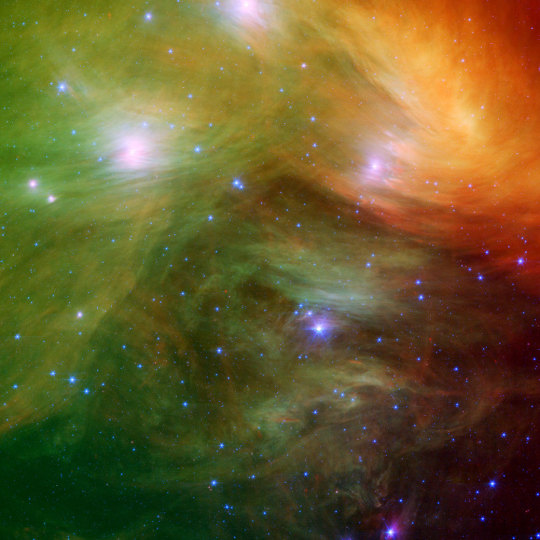
The Pleiades star cluster, also known as the Seven Sisters, is a frequent target for night sky observers. This image from Spitzer zooms in on a few members of the sisterhood. The filaments surrounding the stars are dust, and the three colors represent different wavelengths of infrared light.
Young Stars in Their Baby Blanket of Dust

Newborn stars peek out from beneath their blanket of dust in this image of the Rho Ophiuchi nebula. Called "Rho Oph" by astronomers and located about 400 light-years from Earth, it's one of the closest star-forming regions to our own solar system.
The youngest stars in this image are surrounded by dusty disks of material from which the stars — and their potential planetary systems — are forming. More evolved stars, which have shed their natal material, are blue.
The Infrared Helix

Located about 700 light-years from Earth, the eye-like Helix nebula is a planetary nebula, or the remains of a Sun-like star. When these stars run out of their internal fuel supply, their outer layers puff up to create the nebula. Our Sun will blossom into a planetary nebula when it dies in about 5 billion years.
The Tortured Clouds of Eta Carinae
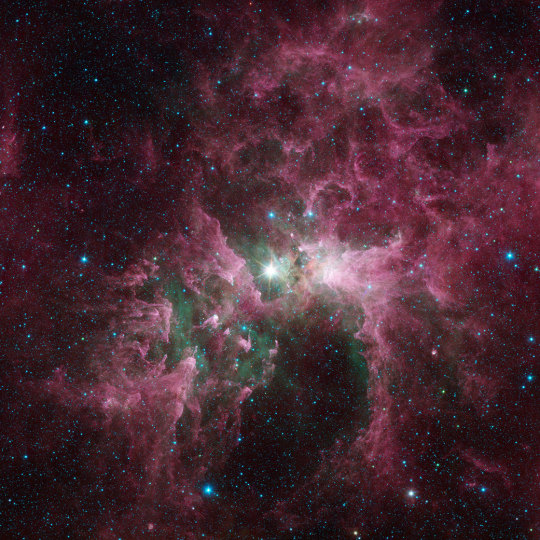
The bright star at the center of this image is Eta Carinae, one of the most massive stars in the Milky Way galaxy. With around 100 times the mass of the Sun and at least 1 million times the brightness, Eta Carinae releases a tremendous outflow of energy that has eroded the surrounding nebula.
Spitzer Spies Spectacular Sombrero

Located 28 million light-years from Earth, Messier 104 — also called the Sombrero galaxy or M104 — is notable for its nearly edge-on orientation as seen from our planet. Spitzer observations were the first to reveal the smooth, bright ring of dust (seen in red) circling the galaxy.
Spiral Galaxy Messier 81
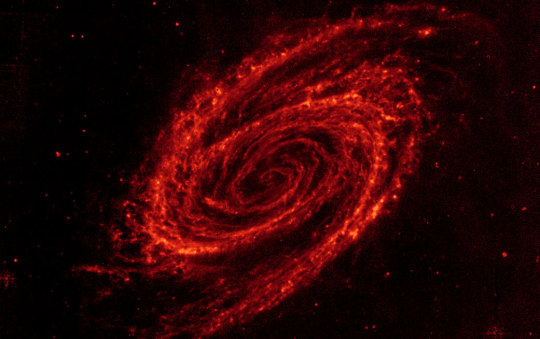
This infrared image of the galaxy Messier 81, or M81, reveals lanes of dust illuminated by active star formation throughout the galaxy's spiral arms. Located in the northern constellation of Ursa Major (which includes the Big Dipper), M81 is also about 12 million light-years from Earth.
Spitzer Reveals Stellar Smoke

Messier 82 — also known as the Cigar galaxy or M82 — is a hotbed of young, massive stars. In visible light, it appears as a diffuse bar of blue light, but in this infrared image, scientists can see huge red clouds of dust blown out into space by winds and radiation from those stars.
A Pinwheel Galaxy Rainbow

This image of Messier 101, also known as the Pinwheel Galaxy or M101, combines data in the infrared, visible, ultraviolet and X-rays from Spitzer and three other NASA space telescopes: Hubble, the Galaxy Evolution Explorer's Far Ultraviolet detector (GALEX) and the Chandra X-Ray Observatory. The galaxy is about 70% larger than our own Milky Way, with a diameter of about 170,000 light-years, and sits at a distance of 21 million light-years from Earth. Read more about its colors here.
Cartwheel Galaxy Makes Waves

Approximately 100 million years ago, a smaller galaxy plunged through the heart of the Cartwheel galaxy, creating ripples of brief star formation. As with the Pinwheel galaxy above, this composite image includes data from NASA's Spitzer, Hubble, GALEX and Chandra observatories.
The first ripple appears as a bright blue outer ring around the larger object, radiating ultraviolet light visible to GALEX. The clumps of pink along the outer blue ring are X-ray (observed by Chandra) and ultraviolet radiation.
Spitzer and Hubble Create Colorful Masterpiece

Located 1,500 light-years from Earth, the Orion nebula is the brightest spot in the sword of the constellation Orion. Four massive stars, collectively called the Trapezium, appear as a yellow smudge near the image center. Visible and ultraviolet data from Hubble appear as swirls of green that indicate the presence of gas heated by intense ultraviolet radiation from the Trapezium's stars. Less-embedded stars appear as specks of green, and foreground stars as blue spots. Meanwhile, Spitzer's infrared view exposes carbon-rich molecules called polycyclic aromatic hydrocarbons, shown here as wisps of red and orange. Orange-yellow dots are infant stars deeply embedded in cocoons of dust and gas.
A Space Spider Watches Over Young Stars
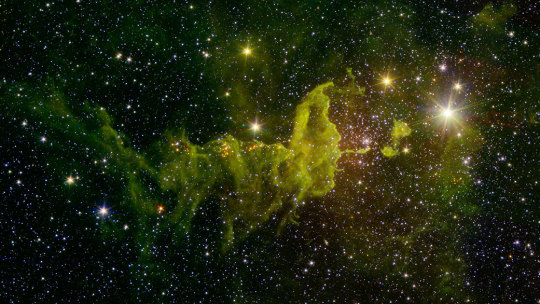
Located about 10,000 light-years from Earth in the constellation Auriga, the Spider nebula resides in the outer part of the Milky Way. Combining data from Spitzer and the Two Micron All Sky Survey (2MASS), the image shows green clouds of dust illuminated by star formation in the region.
North America Nebula in Different Lights
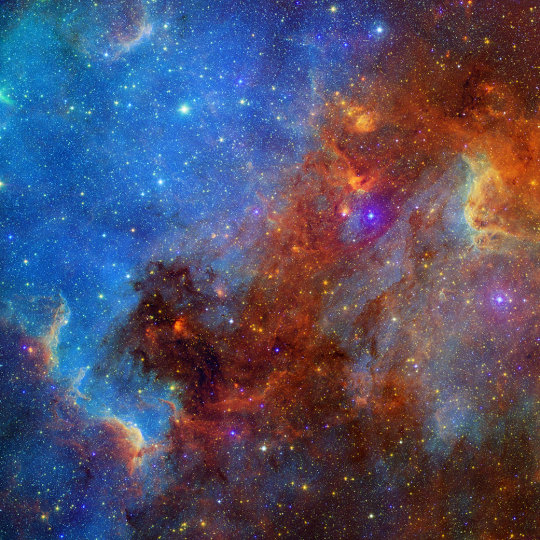
This view of the North America nebula combines visible light collected by the Digitized Sky Survey with infrared light from NASA's Spitzer Space Telescope. Blue hues represent visible light, while infrared is displayed as red and green. Clusters of young stars (about 1 million years old) can be found throughout the image.
Spitzer Captures Our Galaxy's Bustling Center

This infrared mosaic offers a stunning view of the Milky Way galaxy's busy center. The pictured region, located in the Sagittarius constellation, is 900 light-years agross and shows hundreds of thousands of mostly old stars amid clouds of glowing dust lit up by younger, more massive stars. Our Sun is located 26,000 light-years away in a more peaceful, spacious neighborhood, out in the galactic suburbs.
The Eternal Life of Stardust
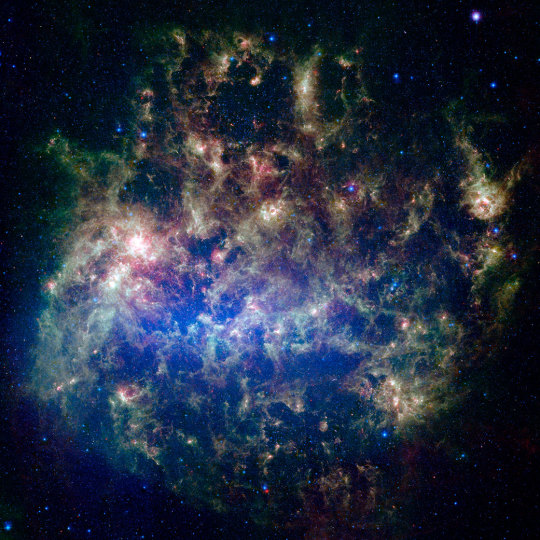
The Large Magellanic Cloud, a dwarf galaxy located about 160,000 light-years from Earth, looks like a choppy sea of dust in this infrared portrait. The blue color, seen most prominently in the central bar, represents starlight from older stars. The chaotic, bright regions outside this bar are filled with hot, massive stars buried in thick blankets of dust.
A Stellar Family Portrait

In this large celestial mosaic from Spitzer, there's a lot to see, including multiple clusters of stars born from the same dense clumps of gas and dust. The grand green-and-orange delta filling most of the image is a faraway nebula. The bright white region at its tip is illuminated by massive stars, and dust that has been heated by the stars' radiation creates the surrounding red glow.
Managed by our Jet Propulsion Laboratory in Pasadena, California, Spitzer's primary mission lasted five-and-a-half years and ended when it ran out of the liquid helium coolant necessary to operate two of its three instruments. But, its passive-cooling design has allowed part of its third instrument to continue operating for more than 10 additional years. The mission is scheduled to end on Jan. 30, 2020.
Make sure to follow us on Tumblr for your regular dose of space: http://nasa.tumblr.com
#NASA#Space#Spitzer Space telescope#Hubble Space Telescope#science#astronomy#space pictures#space photography#space wallpapers#stars#galaxy#milky way galaxy#nebula#space telescope#star formation#star forming region
6K notes
·
View notes
Text

mean 2 him :(
21 notes
·
View notes
Photo




Gorillaz x G-Shock - Mission M101 (Part 3)
97 notes
·
View notes
Video
youtube
Gorillaz x G-Shock - Mission M101 (Part 3)
IT’S FINALLY HERE!
#YEAH BABY#BACK FROM DEATH#back from the grave#gorillaz#gorillaz g-shock#gorillaz x g-shock#gorillazxg-shock#g-shock#YESSSSSS#2d#stuart pot#noodle gorillaz#2d gorillaz#murdoc niccals#russel hobbs
60 notes
·
View notes
Video
youtube
Gorillaz x G-Shock - Mission M101 (Part 3)
19 notes
·
View notes
Photo






Gorillaz x G-Shock - Mission M101 (Part 1)
531 notes
·
View notes